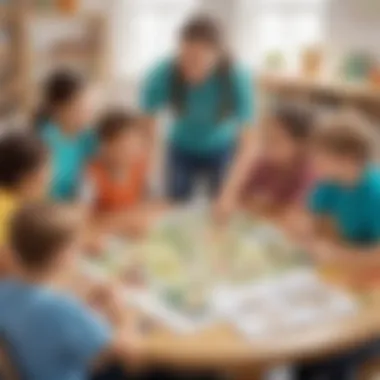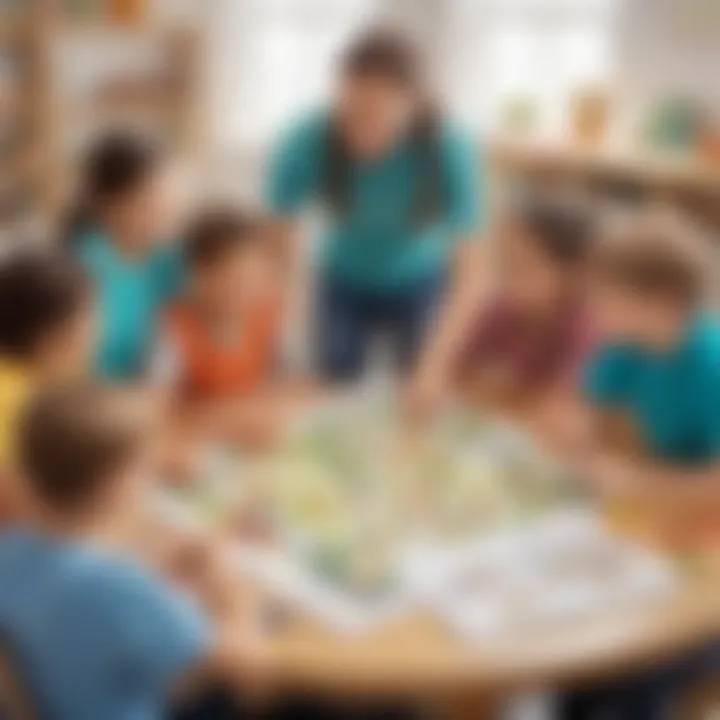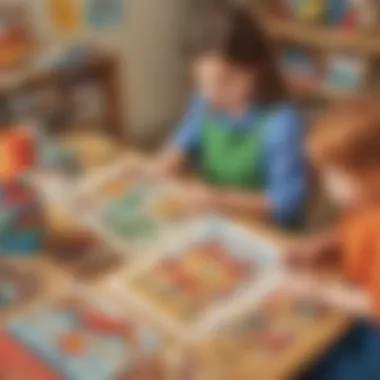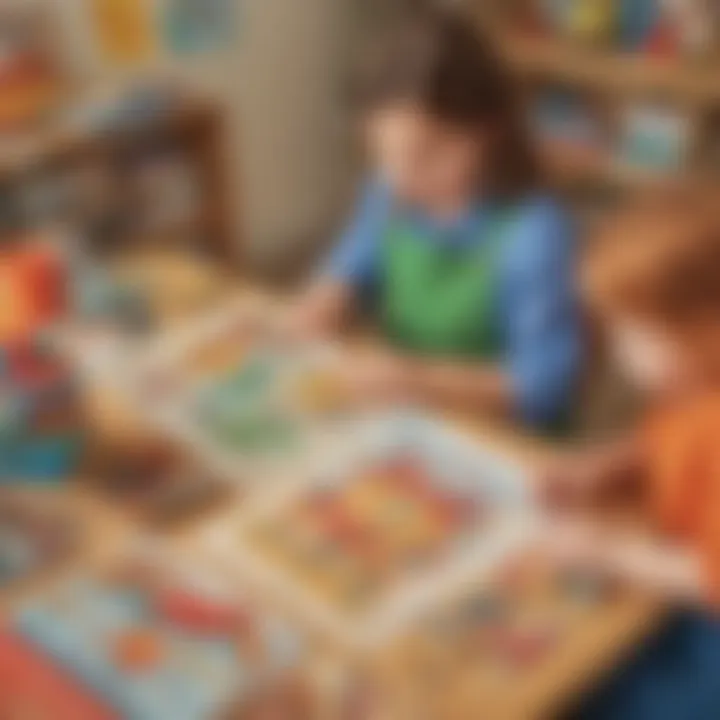Engaging Games for Six-Year-Olds: A Guide


Intro
Engaging games for six-year-olds serve as a crucial tool in both educational and developmental settings. Children at this age are ripe for learning. Their cognitive, social, and physical skills are growing rapidly. Therefore, choosing the right games can have profound impacts on their development. Games that resonate with children at this stage can boost skills such as problem-solving, teamwork, and fine motor coordination. This article explores various engaging games designed for six-year-olds, providing insights for parents and educators.
Creative Activities
Creative activities can cultivate a rich learning experience. By engaging in crafts, children enhance their artistic expression while developing fine motor skills.
Craft Ideas
- Paper Plate Animals: Use paper plates and colored markers to create different animals. This activity promotes creativity and encourages storytelling.
- Nature Collage: Collect leaves and flowers to make a collage. This introduces kids to nature while enhancing their observational skills.
Step-by-Step Guides
- Paper Plate Animals:
- Nature Collage:
- Gather materials: paper plates, scissors, colored markers.
- Draw animal features on the paper plate.
- Cut out additional pieces for ears or tails and glue them on.
- Go outside to collect natural materials.
- Arrange items on paper to create a design.
- Use glue to secure the collage.
Educational Value
Engaging in these creative activities supports several learning outcomes. Art improves fine motor skills. Nature collages help children learn about their environment, fostering a sense of appreciation for the outdoors.
Fun Quizzes
Quizzes are an excellent method for reinforcing learning. They can help assess children’s knowledge while keeping the process enjoyable.
Quiz Topics
Quizzes can cover various themes that appeal to six-year-olds, such as:
- Animals
- Shapes and colors
- Simple math problems
- Famous stories or characters
Question Types
Different types of questions keep children interested. Here are some examples:
- Multiple choice: Simple choices to make learning interactive.
- True/False: Encourages critical thinking on whether statements are correct.
- Fill in the blanks: Helps reinforce memory and understanding.
Knowledge Reinforcement
Fun quizzes aid retention of knowledge. They reinforce what children learn in a way that is engaging and fun, making the learning experience memorable.
Fact-Based Articles
Fact-based articles provide young learners with accessible information. These articles can introduce essential topics in a simplified manner.
Topics
A diverse range of topics can be covered, such as:
- Basic science concepts
- Historical figures and events
- Different cultures around the world
Engaging Content
These articles present information simply and understandably. Pictures and straightforward language grab children's attention. Making learning feel less daunting encourages a love of reading.
Preamble to Interactive Play
Interactive play forms the cornerstone of a child's early experiences. In this age of growing technology, it is vital to return to the basics of traditional play, which is not only enjoyable but also fundamentally important for development. Games serve as a medium where children explore their environment, express creativity, and build social connections. The balance between guided play and child-led discovery is crucial. Educators and parents need to recognize this balance to foster an enriching atmosphere.
The Importance of Play
Play is more than just fun; it is essential for healthy development. Six-year-olds thrive through interaction as they engage with peers and learn from their experiences. Through games, children develop problem-solving skills, creativity, and resilience. Play helps children understand social norms and practice empathy. Furthermore, play is often the first introduction to structured learning. It lays the groundwork for academic skills by encouraging engagement in various activities.
"Play is the highest form of research." - Albert Einstein
Incorporating games into a child's routine can significantly influence their overall learning experience. The experience shapes preferences and inclinations towards subjects they will encounter in school. Thus, recognizing the importance of play in learning outcomes is critical for parents and educators alike.
Developmental Benefits
The benefits of play extend across multiple domains of development:
- Cognitive Development: Games enhance critical thinking. Simple rules require children to strategize, foresee consequences, and make decisions. These cognitive exercises are vital for building robust mental frameworks.
- Social Development: In a game setting, children often navigate complex social scenarios. They learn to cooperate, communicate, and share. These interactions cultivate social skills that are carried into adulthood.
- Physical Development: Whether running in a game of tag or coordinating movements during ball games, physical play fosters gross motor skills. It promotes agility, balance, and overall health.
- Emotional Development: Play provides a safe space for children to express their feelings. It can help them explore emotions like frustration or joy. Through understanding their feelings, they build emotional intelligence, a critical skill for navigating life’s challenges.
Classic Games and Their Relevance


Classic games hold a special place in childhood play. They are not only fun but also foster important skills in young children, especially six-year-olds. These games have been passed down through generations and continue to be relevant due to their simple rules and ability to engage kids in active play. The benefits of these classic games extend beyond enjoyment. They often involve physical movement, social interaction, and cognitive challenges, making them a perfect fit for holistic development.
When children play these games, they learn valuable lessons in cooperation, turn-taking, and following instructions. These experiences are essential as they prepare young learners for group activities in school and beyond. Classic games encourage children to think critically, strategize, and embrace the spirit of fair play. As parents and educators seek ways to enhance play experiences, classic games serve as an effective tool that balances fun with learning.
Simon Says
Simon Says is a game that focuses on listening skills and following instructions. One player takes on the role of "Simon" and gives commands that must be followed only if prefixed with the phrase "Simon says." For example, saying "Simon says jump" means players should jump, while a command without the phrase should be ignored.
This game cultivates attentiveness and enhances verbal comprehension. Children must pay close attention to the specific wording of commands, sharpening their cognitive skills. The physical aspect encourages movement, which contributes to their overall health. Playing Simon Says also allows children to experience success and failure, teaching them resilience as they learn to keep trying.
Duck, Duck, Goose
Duck, Duck, Goose is a classic game typically played in a circle. One child walks around the outside of the circle and taps others on the head, saying "duck" until choosing someone to be the "goose." The chosen child must then chase the tapper around the circle, aiming to take their place.
This game promotes teamwork and spatial awareness. While running and chasing enhance physical powers, the social aspect encourages kids to socialize and communicate. They learn to celebrate wins and manage losses in a fun-filled environment.
Hide and Seek
Hide and Seek is one of the most beloved childhood games. One player closes their eyes and counts at a designated spot while others scatter to find hiding spots. Once counting is complete, the seeker must find those in hiding. This game incorporates suspense and strategy, requiring children to think creatively about where to hide.
The game develops not only physical skills, such as running and climbing, but also social skills by promoting cooperation and patience. Children learn to negotiate turns and understand the importance of waiting. Additionally, Hide and Seek requires memory and critical thinking as players choose where to hide and anticipate the seeker's movements.
"Classic games like Simon Says, Duck, Duck, Goose, and Hide and Seek are more than just fun. They foster cognitive, social, and physical development among six-year-olds."
Creative Games to Spark Imagination
Creative games serve as an essential bridge between play and learning for six-year-olds. These types of games foster critical thinking and allow children's imaginations to flourish. They encourage free thought and creativity, paving the way for children to explore different ideas and scenarios. In a world that highly values innovation, stimulating an imaginative spirit is vital.
The benefits of creative games are multifaceted. They not only enhance cognitive abilities but also strengthen social connections. Engaging in imaginative play often requires collaboration, thus promoting teamwork and communication skills. Moreover, these games can adapt to various group sizes and settings, making them versatile for classrooms or home environments.
Parents and educators should consider that all children express creativity in different ways. Therefore, providing a range of creative games will cater to various interests and abilities, leading to a more inclusive play experience.
Charades for Kids
Charades is an engaging and entertaining game for six-year-olds. It involves acting out a word or phrase without speaking while others guess what it is. This game encourages physical activity and helps develop memory and communication skills.
To play charades, gather a group of children. Each child can take turns acting out a chosen word from a prepared list. Consider using simple categories like animals or actions to make it easier for younger participants. This game often results in laughter and creativity, making it enjoyable for everyone involved.
Benefits of charades include:
- Enhancing vocabulary and language skills.
- Promoting teamwork and cooperation.
- Building confidence as children perform in front of others.
Imaginary Adventures
Imaginary adventures allow children to create their own worlds and stories. In this activity, children can take on different characters and explore varied scenarios. Whether pretending to be a pirate on a treasure hunt or an astronaut discovering a new planet, the opportunities are limited only by their imagination.
Parents and educators can facilitate this game by setting the scene or providing props. For example, a simple blanket can become a spaceship, or cardboard boxes can serve as boats. Encouraging children to share their adventures can also promote storytelling abilities and develop oral communication skills.
Storytelling Games
Storytelling games can be a captivating way for six-year-olds to express their thoughts and ideas. In these games, children can collaborate to create a story, adding new parts as they go along. This collective storytelling nurtures creativity and helps develop narrative skills.
One popular method is the "Story Chain" game, where each child takes turns adding a sentence to a story. This method encourages listening skills and the ability to build upon other's ideas.
Key factors in storytelling games include:
- Teaching narrative structure and sequence.
- Encouraging creativity without judgment.
- Fostering social skills through collaboration.
Engaging in creative games not only entertains six-year-olds but also lays the groundwork for essential skills like communication, teamwork, and critical thinking. Integrating these games in daily routines can significantly enhance a child's developmental journey.
Educational Games with Learning Outcomes
Educational games serve as a crucial bridge between play and learning. They not only captivate the attention of six-year-olds but also impart essential skills in a playful context. The importance of these types of games lies in their ability to merge cognitive development with fun, ensuring that children remain engaged while they learn. Today’s kids thrive in interactive atmospheres where they can explore and experiment, making educational games a vital component in fostering a positive learning environment.
Through the integration of various subjects—be it math, language arts, or science—educational games achieve a dual purpose of entertainment and education. They help children to build foundational knowledge, which is essential as they prepare for more complex concepts in the future. Moreover, these games provide immediate feedback. For instance, in a game setting, if a child makes a mistake, they can learn and correct it right away. This real-time interaction nurtures a growth mindset, making children more resilient when facing challenges in other settings, such as the classroom.
When selecting educational games, it is important for parents and educators to consider the following:
- Age-appropriateness: Ensure the game matches the developmental stage of the child.
- Balance of fun and learning: A good game should not feel like a chore; it must engage the child first.
- Variety of skills: Notice if the game targets multiple areas of learning.
By combining learning outcomes with enjoyable play, educational games can create lasting impressions that extend well beyond the gaming experience itself.
Math Bingo
Math Bingo is a delightful twist on the traditional Bingo game that incorporates arithmetic practice. In this game, players receive Bingo cards filled with various math problems or answers. The caller, usually an adult, calls out specific problems or solutions. The children must solve the math problems on their cards, marking the answers if they match. The first to complete a row or column and shout "Bingo!" is the winner.
The benefits of Math Bingo are numerous. First, it reinforces basic math skills in a non-threatening setting. Children improve their addition, subtraction, and even multiplication skills while enjoying a competitive atmosphere with peers. Additionally, it enhances listening skills as kids need to pay attention to the caller while quickly processing information in their minds. This game is highly adaptable—it can cater to individual needs by altering the complexity of the problems based on a child's skill level.
Word Search Challenges


Word search challenges are another effective educational game that sharpens language skills. In a typical word search, children look for specific words hidden in a grid of letters. Finding these words enhances vocabulary, spelling, and pattern recognition.
Parents and educators can customize word searches to fit particular themes or topics, such as animals, math terms, or historical figures. This adaptability keeps children engaged and eager to learn new words or concepts. The process of searching for words also requires children to focus, which can improve their concentration levels. Furthermore, this game can be played alone or in a group, making it versatile for different learning environments.
Scavenger Hunts
Scavenger hunts are an interactive and engaging way to promote problem-solving and critical thinking skills in children. In this game, children are given a list of items or clues that they must find within a designated area. These hunts can be designed to include educational elements, such as nature scavenger hunts that require kids to find specific leaves or rocks while learning about their properties.
Scavenger hunts can be designed to encourage teamwork, as well, fostering cooperation among participants. They can challenge children to think creatively and work together to achieve a common goal. The elements of adventure add excitement, making learning feel effortless. Additionally, these games can enhance physical activity, helping to meet the need for movement in young children, with the added benefit of outdoor exploration.
Educational games stimulate cognitive skills while keeping the fun aspect alive. This balance ensures that children develop a love for learning early on.
Physical Games to Encourage Movement
Physical games play a crucial role in the development of six-year-olds. At this age, children are full of energy and require outlets for their physical expressions. Engaging in physical activity helps them to not only channel their energy but also promotes essential physical development. Involving children in movement-based games increases their coordination, balance, and overall physical fitness. Furthermore, such games can also enhance their social skills as they often engage with peers during play. The benefits of physical games include increased cardiovascular health, strength building, and improved motor skills.
Children are naturally inclined to move, and games that incorporate movement help them to develop a healthy attitude toward physical activity early on. Parents and educators should focus on creating an environment that fosters active play. Reinforcing the importance of movement through play can lead to a lifetime of healthy habits.
Obstacle Courses
Obstacle courses provide an excellent way for children to enjoy physical activity while also engaging their problem-solving skills. These courses can be tailored to fit the available space, whether indoors or outdoors. Creating a simple course may involve items like cones, ropes, and soft mats. Varied challenges like crawling under a net or jumping over a hurdle can stimulate different muscle groups.
- Improves Coordination: Navigating through an obstacle course requires children to coordinate their movements, balance, and timing.
- Promotes Creativity: Kids can help design the courses, allowing creativity in their play.
- Encourages Teamwork: Children can work in groups, enhancing their ability to cooperate and communicate.
An obstacle course can be setup in minutes. It draws children into a fun activity that enhances their fitness while also improving their cognitive skills.
Ball Games
Ball games are familiar to most children and offer numerous advantages. Playing with balls boosts hand-eye coordination, social skills, and physical fitness. There’s a wealth of options to choose from, such as soccer, basketball, or simple games like catch.
- Social Interaction: Ball games often require teamwork, teaching children how to play fair and communicate with each other.
- Physical Development: Kicking, throwing, and catching actively engage different muscle groups and improve gross motor skills.
- Variety of Skills: Different games emphasize various skills, allowing children to develop well-rounded athletic abilities.
Involving young learners in ball games encourages joy in physical activity while enhancing their social interactions.
Relay Races
Relay races are an exciting option for group play, promoting both speed and teamwork. These races can be easily organized in a backyard or a playground. Children can split into teams and pass a baton or any other object, making the activity dynamic and engaging.
- Fosters Teamwork: Relay races teach children the importance of working together to achieve a common goal.
- Encourages Competition: Healthy competition in races can motivate children to push their limits while still being fun.
- Improves Speed and Agility: Sprinting from one point to another enhances cardiovascular health and builds strength.
Relay races not only involve running but also strategizing as teams decide how best to position their members for success.
Engaging six-year-olds in physical games is advantageous for their development. These games nurture both their physical and social skills, creating a solid foundation for a healthy lifestyle.
Group Games that Foster Teamwork
Group games that foster teamwork offer children valuable experiences outside the confines of traditional learning. They play a crucial role in enhancing not only interpersonal skills but also a child's ability to collaborate effectively. In an age where social interaction can be limited due to various factors, these games provide an essential avenue for children to learn how to work together, solve problems, and celebrate success as a team.
When considering group games, it is critical to focus on the dynamics involved. Effective teamwork entails communication, trust, and mutual respect. Games that require players to strategize collectively help build these attributes. Moreover, participating in group activities can significantly enhance a child's sense of belonging, which is fundamental for emotional health. Through play, children learn to navigate relationships, understand their roles within a group, and develop a sense of accountability to others.
Team Building Activities
Team building activities are an excellent means to cultivate cooperation among six-year-olds. Such games prompt them to practice essential skills. These activities often involve challenges that require collaboration. For example, group puzzle solving is a classic method. Each child must contribute their thoughts to complete the puzzle. Here are some popular ideas for team building activities:
- Group challenges: Tasks that can only be completed successfully with the help of others.
- Problem-solving games: Activities designed to encourage kids to share ideas and reach solutions collectively.
- Role-playing scenarios: Engaging children in situations that mimic real-life dilemmas fosters teamwork.
Capture the Flag
Capture the Flag remains a staple amongst outdoor games. This game is not just entertaining but requires strategic thinking. The premise is simple: two teams compete to capture the opponent's flag while protecting their own. Communication is key as children must discuss tactics and designate roles, such as defenders and attackers. This game is effective in creating bonds among children. It teaches that every player can bring something unique to the strategy, demonstrating how collaboration leads to achieving a common goal.
- Physical activity: Children develop gross motor skills as they run, dodge, and strategize.
- Critical thinking: Players assess risks and make decisions in real-time.
- Conflict resolution: If rules are broken, children must work together to resolve issues amicably.
Tug of War
Tug of War is another timeless choice that exemplifies teamwork. In this game, two teams pull on opposite ends of a rope. It seems simple, but it requires cooperation and synchronization among team members. Children learn about the strength of unity while experiencing the excitement of competition. This game may enhance their physical development as well since it incorporates energy and muscle use.
- Strength in unity: Emphasizes that working as one team can lead to success.
- Team roles: Children may take on leadership or supportive roles, broadening their understanding of group dynamics.
- Healthy competition: Participants experience both victory and defeat, learning resilience and sportsmanship.
Engaging in group games not only makes learning enjoyable but also fosters essential life skills for children.
Games that promote teamwork enable children to grasp the foundations of collaboration and create lasting interpersonal skills. Ensuring a balance of fun and learning is vital in nurturing a child's social development.
Digital Games: Balancing Technology and Play
As the world becomes increasingly digital, parents and educators face the challenge of integrating technology into playtime for six-year-olds. While traditional games foster social interaction and physical activity, digital games have their own set of unique benefits. They can enhance learning opportunities if used judiciously. Finding the right balance between screen time and traditional play is crucial in promoting healthy development.
"Technology, when balanced with physical and social play, can enhance learning experiences for young children."


Educational Apps for Learning
Educational apps play a significant role in engaging young learners. These apps often focus on core subjects like math, reading, and critical thinking. For example, apps like Endless Alphabet and Khan Academy Kids are designed to be visually appealing and interactive, making learning fun and exciting.
Benefits of educational apps include:
- Cognitive Development: Many apps stimulate cognitive skills, essential for foundational learning.
- Personalized Learning: These apps can adapt to different learning styles and paces, offering a tailored experience.
- Motivation: Interactive elements encourage children to explore topics more deeply.
However, it is important for parents to guide their children in choosing quality content. Not all apps are created equal, and ensuring children engage with age-appropriate educational material is vital.
Interactive Online Games
Interactive online games can provide an engaging platform for learning. Similar to educational apps, they offer opportunities to develop various skills, including problem-solving, teamwork, and creativity. Games such as PBS Kids Games encourage children to participate in challenges that foster skills in a fun, interactive way.
Key aspects of interactive online games include:
- Social Interaction: Many games allow children to connect with peers, promoting social skills in a digital context.
- Skill Development: Games can challenge players to think strategically, solve puzzles, and make decisions quickly.
- Variety: A wide range of genres exists, catering to different interests, from adventure to sports.
Still, the amount of screen time must be monitored. Limiting digital playtime encourages children to engage in active play and develop social connections in the real world. Striking a balance between digital and physical play is essential for healthy development.
Safe Outdoor Games
Outdoor games offer a valuable opportunity for children to engage in healthy physical activity, enhance social skills, and explore the natural environment. For six-year-olds, safe outdoor games serve multiple purposes. They provide chances to improve motor skills, build teamwork, and promote cognitive development. By connecting with nature through various games, children can learn about their surroundings while having fun.
When organizing outdoor activities, safety is a priority. Parents and educators must ensure the area is free from hazards and that the games are age-appropriate. Keeping children hydrated and protecting them from excessive sun exposure are also vital considerations.
Nature Exploration Games
Nature exploration games encourage children to venture outside and immerse themselves in the natural world. These games can range from simple scavenger hunts to structured activities, where children identify plants, insects, and different terrains.
Some engaging nature exploration games include:
- Scavenger Hunt: Create a list of natural items for children to find, such as specific leaves, rocks, or flowers.
- Nature Bingo: Design a bingo card with images of wildlife, trees, or flowers. As children spot these items, they can mark them off on their cards.
- Animal Tracking: Teach children to recognize animal tracks or sounds. This game enhances their observation skills and encourages curiosity about wildlife.
These activities not only encourage physical activity but also develop observation skills and foster a sense of wonder about nature.
Outdoor Sports
Engaging children in outdoor sports allows them to develop coordination, teamwork, and leadership abilities. Basic sports can be adapted to suit the skills of six-year-olds, making them inclusive and fun for all participants.
Examples of sports suitable for this age group include:
- Kickball: A simple game similar to baseball that everyone can enjoy. It promotes teamwork and running skills.
- Soccer: Playing soccer enhances motor skills, hand-eye coordination, and offers an opportunity to learn about sportsmanship.
- Tag: A traditional game that needs no special equipment. It develops speed and encourages children to be active outdoors.
These sports are fundamental in not just improving physical aptitude, but they also help cultivate a group dynamic where children learn the importance of teamwork.
Implementing Games at Home and School
Games play a vital role in the development of six-year-olds. They should be integrated into daily routines at home and in educational settings. Not only do games provide entertainment, but they also enhance learning and social skills. Engaging children in these activities promotes a well-rounded development.
Creating a balanced environment encourages active participation. Parents and educators should strive to include games that cater to various skills. Physical games bolster motor skills, while educational games focus on cognitive growth. This connection helps in fostering a lifelong love for learning.
Another key aspect is the flexibility in incorporating games. They can be adapted for different settings, whether at home or in the classroom. This adaptability allows for continuous engagement of children. Ultimately, implementing games nurtures an interactive atmosphere, which is crucial for the growth of young minds.
Creating a Game-Friendly Environment
A game-friendly environment serves as a foundation for effective play. This involves ensuring ample space and resources for children to engage freely. Both parents and educators should prioritize creating a safe and inviting atmosphere. It is essential to remove distractions and obstacles that hinder play.
Consider the following elements when setting up:
- Space: A clear area allows children to move freely and focus on their activities.
- Resources: Provide a mix of physical and cognitive game materials, such as balls, puzzles, and art supplies.
- Accessibility: Ensure that games and equipment are easily reachable for children. This encourages independent exploration.
Moreover, displaying game rules and objectives prominently can facilitate understanding. Children can refer to these guidelines whenever needed, reinforcing their learning process. Having a strong game-friendly environment ultimately lays the groundwork for enriching play activities.
Involving Parents and Educators
Collaboration between parents and educators is key to enhancing a child's gaming experience. Both parties should work together to promote meaningful engagement in games. Active involvement leads to a deeper connection to learning.
To strengthen this partnership, consider these actions:
- Communication: Regular discussions about a child’s interests and progress encourage support in selecting suitable games. This ensures games resonate with the child's developmental stage.
- Joint Participation: Organizing group activities can merge the efforts of parents and educators. This approach fosters teamwork and provides a sense of community, making the games more enjoyable.
- Feedback Mechanism: Creating open channels for feedback allows both sides to understand what works best. Adjusting games based on observations helps in maintaining engagement levels.
Integrating contributions from both parents and educators results in a richer experience for children. It provides them with a robust support system that extends beyond academic learning. Overall, early involvement of both parties is crucial in helping children reap the benefits of engaging games.
Finale: The Value of Play in Development
Play is not merely a leisure activity for six-year-olds; it is a fundamental aspect of their growth and development. This section emphasizes that play serves as a primary mechanism through which children learn about themselves and the world around them. Engaging games facilitate cognitive, physical, and social development. They allow children to explore their creativity, improve problem-solving skills, and develop crucial social interactions.
Encouraging Lifelong Learning
The role of games extends beyond immediate fun. By engaging in various play activities, children develop a love for learning that can last throughout their lives. This is especially vital in early childhood, where the foundation for future education is built. During play, children encounter challenges that require them to think critically, make decisions, and reflect on their experiences. These actions foster a growth mindset, encouraging them to embrace challenges rather than shy away.
Moreover, games can introduce children to new concepts and skills in a manner that feels natural and enjoyable. For instance, problem-solving in a game of Math Bingo not only enhances their numeracy skills but also teaches persistence and resilience. Such lessons are essential as they progress through school and into adulthood.
"Play is the highest form of research." – Albert Einstein







